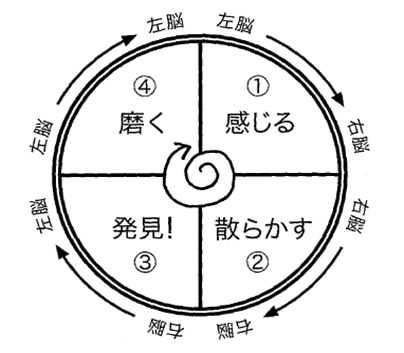 |
 |
Anmira's Dutch Apple Pie is delicious with its crispy texture!
|
After a dark, gloomy two-year gap year, I finally arrived at my first day of university. My first friend there was Karube-kun. Originally from Osaka, he was friendly and talkative. I remember stopping by Anna Millers on the way home, ordering Dutch apple pie and refilling my coffee endlessly while we chatted about nothing in particular. Karube-kun, nicknamed "Karubin Tofura" after Alvin Toffler's then-popular book 'The Power Shift', is now an Associate Professor at Hitotsubashi University's Innovation Research Center. His co-authored work, 'The Reason for Innovation: The Creative Justification of Resource Mobilization', won the 55th Nikkei Economic Book Culture Award.
 |
Professor Karubin Tofura
|
To realize innovation, revolutionary ideas must be commercialized and tested in the real world. However, precisely because innovation involves new endeavors, it is difficult to demonstrate a clear prospect of success beforehand. A common issue here is that companies hesitate to commit resources—people, materials, money, and information—to highly uncertain, innovative attempts. When that happens, promising innovations often fail to materialize. This book explores how to overcome this reality—often called the "Valley of Death"—that hardworking people frequently face.
 In circular thinking, you first enter "scatter" mode, using physical thinking to roll around and exhaust every possible angle. Then, in "discovery!" mode, you rigorously verify logical consistency by asking, "Can this perspective actually solve the problem?" The concept (idea) gained this way is a ray of light showing a "Why didn't I think of that?" solution. However, it becomes prime fodder for the "critics" found in every organization. "Prove that this concept is superior to the current approach," "You can't even evaluate it properly without at least three concept candidates," and so on. It often comes to a screeching halt right before the "Polish" mode, where various resources are introduced to create concrete plans. So-called "concept research" is like showing ordinary people Taro Okamoto's work and suddenly asking, "Is 'Art is an Explosion' appealing?" How many projects repeat this cycle, still unable to decide, and tumble down the "Valley of Death"?
In circular thinking, you first enter "scatter" mode, using physical thinking to roll around and exhaust every possible angle. Then, in "discovery!" mode, you rigorously verify logical consistency by asking, "Can this perspective actually solve the problem?" The concept (idea) gained this way is a ray of light showing a "Why didn't I think of that?" solution. However, it becomes prime fodder for the "critics" found in every organization. "Prove that this concept is superior to the current approach," "You can't even evaluate it properly without at least three concept candidates," and so on. It often comes to a screeching halt right before the "Polish" mode, where various resources are introduced to create concrete plans. So-called "concept research" is like showing ordinary people Taro Okamoto's work and suddenly asking, "Is 'Art is an Explosion' appealing?" How many projects repeat this cycle, still unable to decide, and tumble down the "Valley of Death"?
In his book The Reason for Innovation, Karube-kun warns that precisely because of this, realizing innovation requires "the totality of ingenuity and effort to leverage diverse reasons, proactively pioneer diverse routes, engage diverse people, and enable continuous resource mobilization." He also sounds the alarm: "Japanese society, with its high dependence on innovation from large corporations, may be becoming less capable of generating innovation." So, how about in your own surroundings?
Thanks to you all, this column concludes for the year. Merry Christmas & Happy New Year. May this year bring you ever greater progress, good health, and the realization of as many innovations as possible beyond the "Valley of Death."
Enjoy!




 In circular thinking, you first enter "scatter" mode, using physical thinking to roll around and exhaust every possible angle. Then, in "discovery!" mode, you rigorously verify logical consistency by asking, "Can this perspective actually solve the problem?" The concept (idea) gained this way is a ray of light showing a "Why didn't I think of that?" solution. However, it becomes prime fodder for the "critics" found in every organization. "Prove that this concept is superior to the current approach," "You can't even evaluate it properly without at least three concept candidates," and so on. It often comes to a screeching halt right before the "Polish" mode, where various resources are introduced to create concrete plans. So-called "concept research" is like showing ordinary people Taro Okamoto's work and suddenly asking, "Is 'Art is an Explosion' appealing?" How many projects repeat this cycle, still unable to decide, and tumble down the "Valley of Death"?
In circular thinking, you first enter "scatter" mode, using physical thinking to roll around and exhaust every possible angle. Then, in "discovery!" mode, you rigorously verify logical consistency by asking, "Can this perspective actually solve the problem?" The concept (idea) gained this way is a ray of light showing a "Why didn't I think of that?" solution. However, it becomes prime fodder for the "critics" found in every organization. "Prove that this concept is superior to the current approach," "You can't even evaluate it properly without at least three concept candidates," and so on. It often comes to a screeching halt right before the "Polish" mode, where various resources are introduced to create concrete plans. So-called "concept research" is like showing ordinary people Taro Okamoto's work and suddenly asking, "Is 'Art is an Explosion' appealing?" How many projects repeat this cycle, still unable to decide, and tumble down the "Valley of Death"?
